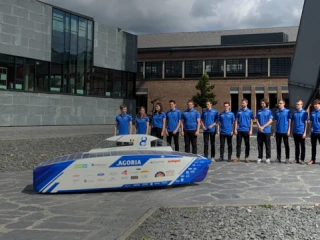Energy-efficient and innovative
The BluePoint is the eighth Belgian solar car and is, at the same time, the most aerodynamic vehicle from Belgium. The aerodynamic shape of the vehicle was tinkered for six months in order to get the air resistance this low. “We are proud of the result that we’ve achieved. During the whole race of 3000 kilometers through Australia, the energy consumption of the BluePoint will, according to the calculations, be equivalent to 7 liters of diesel”, said Emmerick Vandervelpen, aerodynamic engineer on the Agoria Solar Team.
Besides the improvements in the aerodynamic sense, there are a few ‘firsts’ in the BluePoint. It’s, for example, the first time that the students have developed the solar panel themselves. In the past, the Belgian Solar Team always used to buy a proprietary panel. By manufacturing the panel themselves, the team has more control over the production process. This year they chose the most suitable solar cells themselves, connected them and then enveloped the cells with a protective coat. The solar cells are extremely fragile so coating them is a tricky process. Nelis Geurts, the team member in charge of the solar panel: “The solar cells are a lot more energy-efficient than the ones that you see on the roofs in your street. They are also used on satellites and cost as much as a Lamborghini!”
